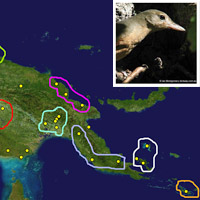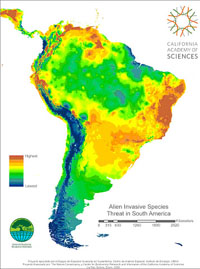List of Research Projects and Descriptions

|
New Guinea is the world’s largest tropical island, boasting vast tracts of lowland forest
and rich faunal assemblages. Many lowland bird species are commonly “lumped” into a single
species because their habitat is continuous and assumed to be homogeneous. Emerging phylogeographic
research by Dr. Jack Dumbacher, Chairman and Assistant Curator of the Department of Ornithology and
Mammalogy at the Academy and Kristy Deiner, Ph.D. student in the Ecology Graduate Group at UC Davis
has identified previously unrecognized diversity among New Guinea lowland birds.
|

|
Invasive alien species (IAS) are the second most important cause of biodiversity loss
next to habitat alteration and climate change. In Latin America, economic losses from IAS
amount to billions of dollars annually, but strategies to minimize the damage of IAS are
generally underdeveloped. Together with researchers from The Nature Conservancy (TNC),
and the Centro de Analisis Espacial of the Universidad Mayor de San Andres in Bolivia,
CBR is using ensemble distribution modeling to generate composite maps that predict
the distribution of 150 of the most threatening IAS in South America.
|
Research Projects |
Visit our six research project areas here
Personnel |
CBR Director, staff, students, and collaborators.
Acknowledgements |
See a list of our supporters.
Contact Info |
For general inquiries about CBR please contact:
CBR Administrator![]() 415-379-5201
415-379-5201
![]() lirving@calacademy.org
lirving@calacademy.org
